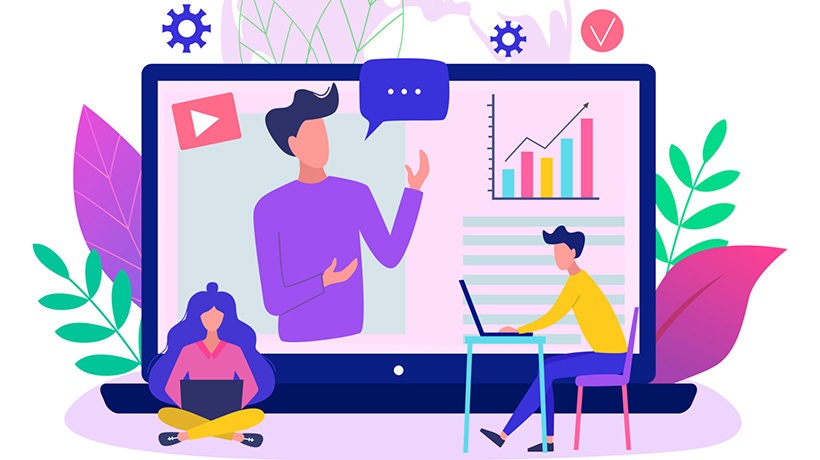Blended Learning Models And Workplace Learning
What’s the perfect “blend” for blended learning when it comes to workplace learning?
Which Blended Learning Models Work Best In The Workplace?
There have been many blended learning models introduced over the years. Unfortunately, these models have some limitations in an organizational context. Despite these limitations, there are two models in particular that seem to offer the most flexibility to accommodate organizational needs. These are the Online Driver Model and the Self-Blend Model.
1. Online Driver Model
In the Online Driver Model, the majority of the coursework is completed online, but some in-person activities are required. This model offers flexibility for employees spread out over a wide geographical area and saves both time and money compared to the blended face-to-face class model.
The Online Driver Model does, however, have its downsides. Since there is still a mandatory in-person aspect, some travel is still required. There are also technological considerations that must be made. For this model to be successful, an organization must ensure they have the technical capacity and scalability and are willing to pay for the travel costs associated with in-person training.
2. Self-Blend Model
The Self-Blend Model is a model that offers learners flexibility in a way others do not. While in-person instruction is the primary method of delivery, the learner has access to additional online content and is free to select specific courses they want to take. This gives the learner access to content they may not have otherwise had and the ability to create a personalized learning plan.
The downside to this type of blended learning model, however, is that it relies heavily on in-person instruction. While this may be well-suited to the educational environment, most organizations are not operating out of a single building. This makes in-person instruction difficult and costly for many organizations.
A Different Approach To Blended Learning Models
Because of the educational roots most blended learning models have, it is sometimes difficult to apply these in an organizational setting. Remote employment has increased by nearly 50% in just 5 years, and this trend will likely continue. Many organizations are also geographically dispersed.
Now may be the time to consider a different blended learning model. One that can accommodate the shifting workforce dynamics and address the distinct challenges blending learning poses for organizations.
The Social-Flex Model
Although the Social-Flex Model is not an official blended learning model, it draws from practices that many organizations with a large, geographically-spread workforce use. It also pulls some characteristics of the Online Driver Model and the Self-Blend Model while incorporating social learning, in turn presenting a unique take on blended learning in an organizational environment.
There are 4 characteristics that set the Social-Flex Model apart from other models:
- Formal classroom learning is replaced by online and informal, face-to-face learning
- Learners have access to immediate 1:1 virtual support.
- Learning is mastery-based and self-driven.
- Social learning is a key ingredient of the blend.
1. Formal Classroom Learning Is Replaced By Online And Informal, Face-To-Face Learning
When we define blended learning, we often think of it as a combination of classroom and online learning methods. But in today’s modern workplace, formal classroom-based learning is becoming less relevant. Instead of the formal, in-person training typically found with other blended learning models, training with the Social-Flex Model is done almost entirely online.
In this model, learning is done through a variety of virtual asynchronous or synchronous instruction methods. This often includes webinars, virtual calls, and eLearning modules. Learners then have the opportunity to informally learn from co-workers and supervisors during their face-to-face interactions.
2. Learners Have Access To Immediate 1:1 Virtual Support
Another key characteristic of the Social-Flex Model is that learners have access to immediate support during business hours. Some organizations do this with a team of “support staff” that monitor an online chat. Others opt to use a phone system or virtual call. Support can also come in the form of a chatbot that escalates issues to a live person, when needed.
The “how” isn’t important. What matters is that the learner has support right when they need it.
3. Learning Is Mastery-Based And Self-Driven
Throughout the blended learning experience in this model, the learner progress through different stages (e.g., beginner, intermediate, advanced). While the learner may have mandatory training(s) for each stage (asynchronous or synchronous), the rest is self-driven.
The learner is given access to multiple online formats to choose from (eLearning, videos, webinars, etc.) and takes an assessment when they are ready to progress to the next stage. If they are unable to progress, a peer mentor or coach is assigned to virtually work 1:1 with the learner.
4. Social Learning Is A Key Ingredient Of The Blend
Virtual social learning is another crucial characteristic of the Social-Flex Model. Ever since Bandura first introduced the social learning theory, it has been a large part of educational and training programs.
The Social-Flex Model draws on these concepts and requires that learners have space to interact and engage with each other. Knowledge sharing and discussion are encouraged, and "communities of practice" are frequently found in organizations that use this model.
Addressing Workplace Blended Learning Challenges
The Social-Flex Model offers solutions to many workplace blended learning challenges. Since virtual 1:1 support is available, learners can access content when needed and receive additional guidance if they don’t understand something. The social aspect ensures staff is engaged and connected in a way other models may not, and the flexible content considers learners’ unique learning preferences.
By drawing on the social learning theory, informal learning, and incorporating the best characteristics of other blended learning models, the Social-Flex Model offers organizations a new way to approach blended learning.
References:
- Bandura, A. (1977). Social learning theory. Englewood Cliffs, NJ: Prentice Hall.
